Czy kiedykolwiek próbowałeś otworzyć jeden ze swoich postów WordPress tylko po to, aby zostać powitanym przez błąd 404? Czasami doświadczamy tego, gdy pracujemy nad własnymi witrynami WordPress lub pomagamy naszym użytkownikom.
Błąd ten pojawia się, gdy można uzyskać dostęp do obszaru administracyjnego WordPress i bloga, ale przy próbie otwarcia konkretnego posta pojawia się komunikat “404 Not Found”.
Pozorne zniknięcie treści może być frustrujące, ale znaleźliśmy kilka obejść, które poprawią ten problem. W tym kompletnym przewodniku pokażemy, jak poprawić posty WordPress zwracające błędy 404.

Dlaczego moje wpisy na WordPressie zwracają błąd 404?
Istnieje kilka powodów, dla których Twoje posty mogą wyświetlać błąd 404 “Nie znaleziono strony” w WordPress. Mogą one obejmować:
- Konflikty wtyczek lub motywów: Czasami wtyczki lub motywy, które zainstalowałeś na swojej witrynie, mogą zakłócać sposób, w jaki WordPress obsługuje bezpośrednie odnośniki. Może to prowadzić do niedziałających odnośników i błędów 404.
- Problemy z własnym kodem: Jeśli dodałeś niestandardowy kod do swojej witryny internetowej, mogą występować błędy w kodzie, które mają wpływ na bezpośrednie odnośniki lub powodują inne konflikty, powodując błędy 404 dla twoich wpisów.
- Problemy z plikiem .htaccess: Plik .htaccess odgrywa rolę w strukturze adresów URL WordPress. Jeśli plik ten jest uszkodzony lub go brakuje, może to prowadzić do błędów 404 dla postów lub stron.
Jak znaleźć wszystkie posty WordPress z błędem 404?
Zanim przejdziemy do rozwiązań, dobrze byłoby dowiedzieć się, czy ten błąd występuje tylko w jednym lub dwóch postach, czy w wielu postach. W ten sposób można określić zakres problemu i wybrać najbardziej odpowiednie rozwiązanie.
Jednym z łatwych sposobów, aby to sprawdzić, jest skorzystanie z Google Search Console. Jeśli jeszcze nie przesłałeś swojej witryny do Google Search Console, przeczytaj nasz przewodnik na temat dodawania witryny WordPress do Google Search Console.
Gdy bot Google zaindeksuje Twoją witrynę, Google Search Console dostarczy Ci szczegółowych informacji o jej wydajności, w tym o napotkanych błędach 404.
Aby dowiedzieć się, które posty zwracają błędy 404, możesz zalogować się do kokpitu Search Console. Następnie przejdź do raportu “Strony”, a zobaczysz szczegółową listę wszystkich błędów.
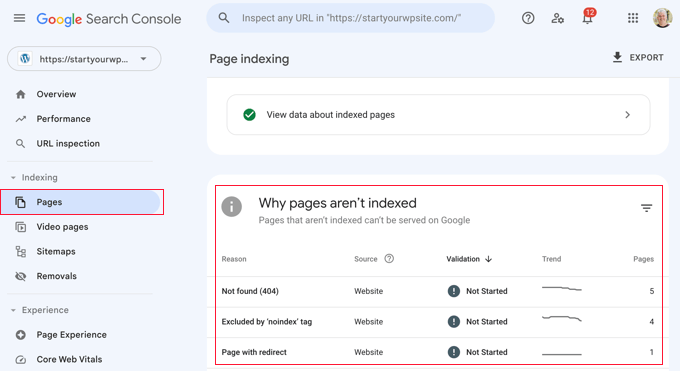
Aby uzyskać więcej informacji, możesz przeczytać naszą listę wskazówek dotyczących korzystania z Google Search Console w celu zwiększenia ruchu w witrynie, która zawiera kilka wskazówek, jak poprawić błędy 404 za pomocą tego narzędzia.
W związku z tym przyjrzyjmy się, jak poprawić wpisy WordPress zwracające błędy 404. Możesz skorzystać z poniższych odnośników, aby przejść bezpośrednio do różnych rozwiązań:
Nie masz czasu na samodzielne poprawki błędów 404? Usługi WPBeginner Pro mogą pomóc! Dzięki naszemu niedrogiemu wsparciu WordPress w nagłych wypadkach możesz zatrudnić ekspertów, którzy poprawią błędy 404, niedziałające linki, problemy z przekierowaniami i wiele więcej. Przestań stresować się problemami z WordPressem i popraw je! Zaplanuj awaryjną obsługę WordPress już dziś!
Metoda 1: Sprawdzenie konfliktów wtyczek lub motywów i problemów z własnym kodem
Czasami wtyczki, motywy lub niestandardowy kod dodany do witryny WordPress mogą zakłócać permalinki lub powodować konflikty, prowadząc do błędów 404. Doświadczyliśmy tego nawet sami podczas testowania narzędzi na naszej stronie demonstracyjnej.
Jednym ze sposobów rozwiązania tego problemu jest tymczasowe wyłączanie wtyczek. Wtyczki mogą czasami zakłócać sposób, w jaki WordPress obsługuje odnośniki.
Po wyłączeniu wtyczek możesz je ponownie aktywować, sprawdzając jednocześnie, czy błąd 404 pojawia się ponownie po włączaniu każdej z nich. Jeśli błąd pojawia się po włączaniu konkretnej wtyczki, to ona może być winowajcą.
Następnie można szybko wyszukać w Google rozwiązania związane z tą wtyczką lub skontaktować się z twórcą wtyczki w celu uzyskania obsługi.
Podobnie, twój motyw WordPress może powodować konflikt.
Aby to sprawdzić, możesz tymczasowo przełączyć się na domyślny motyw WordPress, taki jak Twenty Twenty-Three lub Twenty Twenty-Four. Wystarczy przejść do Wygląd “ Motywy i kliknąć “Włączanie” domyślnego motywu.

Jeśli błąd 404 zniknie z domyślnym motywem, oznacza to potencjalny konflikt z twoim obecnym, aktualnym motywem. Możesz wtedy spróbować rozwiązać problem z motywem lub rozważyć użycie innego motywu.
Możesz sprawdzić nasz ekspercki wybór najpopularniejszych motywów WordPress, aby uzyskać rekomendacje.
Jeśli niedawno wstawiłeś fragmenty kodu do twojej witryny internetowej, mogą występować błędy w kodzie powodujące błędy 404. Przyjrzyj się uważnie dodanemu kodowi i sprawdź, czy możesz zidentyfikować jakieś błędy.
Najbezpieczniejszym sposobem dodawania fragmentów kodu do WordPressa jest użycie wtyczki WPCode. Wtyczka ta pozwala wstawić własny kod bez bezpośredniej pracy z plikami motywu, zmniejszając ryzyko zepsucia twojej witryny internetowej.
Ponadto, gdy WPCode wykryje błąd w twoim kodzie, automatycznie wyłączy fragment kodu i poprosi cię o jego sprawdzenie. Możesz również użyć trybu testowego, aby sprawdzić, czy twój kod działa, zanim prześlesz go do swojej witryny internetowej.

Jeśli żadne z tych rozwiązań nie zadziała, przejdź do następnej metody, w której rozwiążemy problemy z ustawieniami twojego bezpośredniego odnośnika.
Metoda 2: Popraw ustawienia twojego permalinka
Wpisy WordPress mogą zwracać błędy 404 z powodu problemów z regułami przepisywania w twoim pliku .htaccess. W większości przypadków możesz poprawić ten problem, aktualizując ustawienia bezpośredniego odnośnika.
Po prostu przejdź do Ustawienia ” Bezpośrednie odnośniki w twoim panelu administracyjnym WordPress i kliknij przycisk “Zapisz zmiany”.

Nie ma potrzeby wprowadzania zmian w samych ustawieniach bezpośrednich odnośników. Zaktualizuje to twoje ustawienia bezpośredniego odnośnika i wyczyści reguły przepisywania.
W większości przypadków rozwiązanie to poprawi błąd 404 wpisów WordPress. Jeśli jednak nie działa ono w twoim przypadku, to prawdopodobnie musisz ręcznie zaktualizować swój plik .htaccess.
Metoda 3: Aktualizacja pliku .htaccess WordPressa
Zanim zaczniesz, upewnij się, że najpierw wykonałeś kopię zapasową twojego pliku .htaccess WordPress. Jeśli coś pójdzie nie tak, możesz łatwo przywrócić oryginalny plik.
Teraz musisz połączyć się z twoim serwerem za pomocą klienta FTP, takiego jak FileZilla lub aplikacji File Manager w kokpicie hostingu WordPress.
Następnie należy znaleźć i edytować plik .htaccess, który znajduje się w tej samej lokalizacji co katalogi takie jak /wp-content/ i /wp-includes/.
Wystarczy kliknąć plik prawym przyciskiem myszy i wybrać opcję “Uprawnienia pliku”.
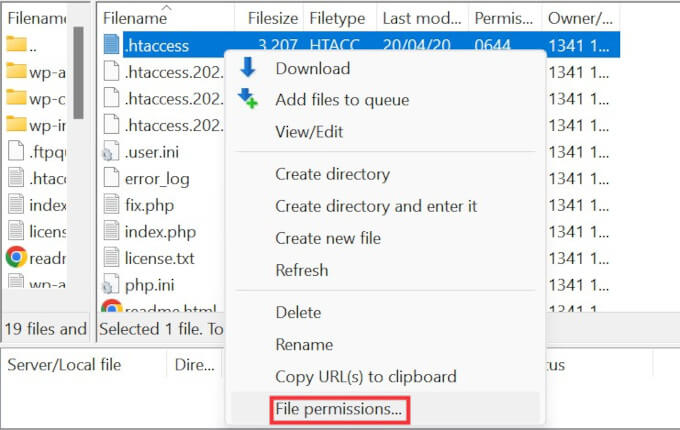
Plik można zapisać, zmieniając jego uprawnienia na 666.
Po prostu wpisz “666” w polu “Wartość liczbowa”, a następnie kliknij “OK”.

Następnie należy powtórzyć kroki z pierwszej metody naszego poradnika. Po wykonaniu tej czynności nie zapomnij zmienić uprawnień z powrotem na 660.
Można również edytować plik i dodawać do niego kod.
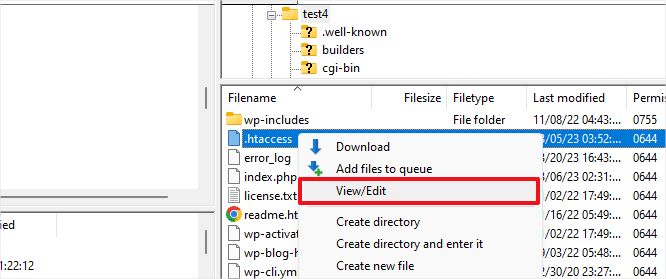
Po otwarciu pliku .htaccess za pomocą edytora tekstu, wystarczy wstawić ten kod:
1 2 3 4 5 6 7 8 9 10 | # BEGIN WordPress<IfModule mod_rewrite.c>RewriteEngine OnRewriteBase /RewriteRule ^index\.php$ - [L]RewriteCond %{REQUEST_FILENAME} !-fRewriteCond %{REQUEST_FILENAME} !-dRewriteRule . /index.php [L]</IfModule># END WordPress |
Metoda 4: Skontaktuj się z dostawcą hostingu
Jeśli żadne z powyższych rozwiązań nie naprawiło błędu 404 zwracającego wpisy WordPress, zalecamy skontaktowanie się z dostawcą hostingu WordPress. Może to być błąd po ich stronie lub mogą oni pomóc w rozwiązaniu problemu.
Zapoznaj się również z naszym przewodnikiem na temat tego, jak prawidłowo poprosić o pomoc techniczną WordPress i ją uzyskać.
Metoda 5: Włącz mod-rewrite (lokalna instalacja WordPress)
Jeśli używasz regionalnego serwera do celów testowych, musisz włączyć mod_rewrite w konfiguracji Apache twojej witryny MAMP, WAMP lub XAMPP.
Pozwoli to WordPressowi na generowanie czystych adresów URL i zapobiegnie błędowi 404 dla wpisów i stron na twoim serwerze lokalnym.
Sposób wykonania tej czynności zależy od używanej platformy. Osoby korzystające z XAMPP mogą otworzyć swój panel sterowania i kliknąć przycisk “Konfiguracja” w ramach działań. Następnie należy wybrać “Apache (httpd.conf)”.
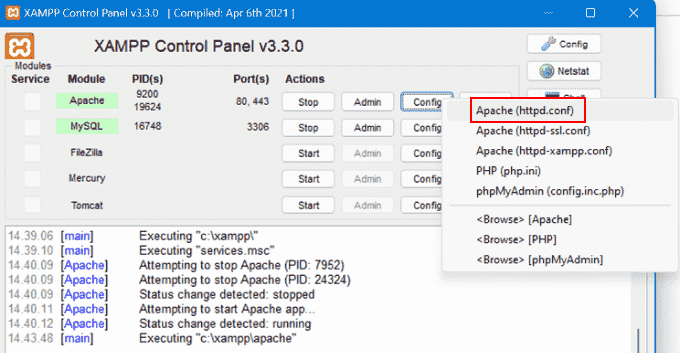
Następnie należy znaleźć linię #LoadModule rewrite_module modules/mod_rewrite.so i usuwać ‘#’, aby ją odkomentować.
Spowoduje to wczytywanie mod_rewrite.
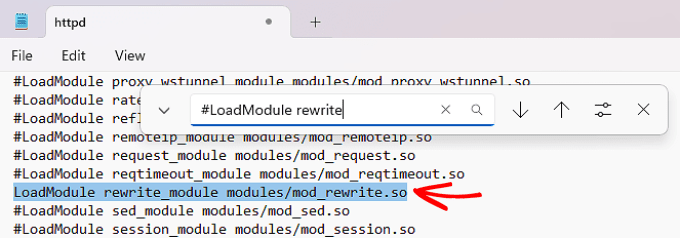
Następnie znajdź wszystkie instancje AllowOverride None i zmień je na AllowOverride All.
Wartość “All” oznacza, że wszystkie dyrektywy mogą zostać zastąpione.

Po zakończeniu można zapisać plik httpd.conf i zamknąć go. Następnie w panelu sterowania XAMPP kliknij “Stop” na module Apache i “Start” ponownie, aby go ponownie uruchomić.
Następnie wróć do kokpitu administratora, aby sprawdzić, czy twoje bezpośrednie odnośniki działają.
Film instruktażowy
Jeśli potrzebujesz instrukcji wizualnych, obejrzyj poniższy film.
Mamy nadzieję, że ten artykuł pomógł Ci rozwiązać problem postów zwracających błędy 404 w WordPress. Możesz również zapoznać się z naszym przewodnikiem po najczęstszych błędach WordPress i sposobach ich poprawki, a także z naszymi eksperckimi propozycjami najlepszych wtyczek WordPress do rozwoju Twojej witryny.
If you liked this article, then please subscribe to our YouTube Channel for WordPress video tutorials. You can also find us on Twitter and Facebook.





Abs
It helps.. just on permalink, already fix my error..
Thanks for this article..
Julius
Mine is a little different. All the pages are working fine but I get “page not found” when working in some places in the dashboard. Let’s say for example I’m creating a new page from the dashboard. When I click on publish I get a 404 error.
And I’ve tried everything above but it’s not working.
Iron65
Thanks for the tip!! the permalink really saved me!!! In case if any other suffered this by updating Yoast SEO or by just deleting cache, try that one, it will fix it
Monica
I have been trying to fix this permalink issue in my site for months and now I did it with your instructions. I don’t know why I did everything you said already and after writing the 644 permissions to fix the httaccess file, it went back to non-writeable. Now I did it and fixed the permissions and wrote your code and it worked. i really don’t know which was the difference but this time it did. Maybe that I already fixed the httaccess in the original folder where I have a subfolder with my blog. That is the only thing I did differently. Thanks a lot
Rais Dar
I am getting a 404(page not found) on my site. What should i do as i tried your methods but still error persists
Chetan
I had faced the same kind of problem. I used to get 404 Page Not Found error for a page. But the reason was that I and used a permalink slug that was associated with some default page in WordPress. e.g. http://example.com/posts – This is WRONG. Because I cannot use ‘posts’ as permalink slug. It is already reserved for some WordPress page. When I changed it to ‘my-posts’, so that now my permalink read: http://example.com/my-posts, the error was gone!
md
hi ,
i had same htaccess .,however , i delete it and import new one but still same .
dumb
hay guys ….
when i change the permalink to anything other than default, my pages wont work i get this error message
“The requested URL /wordpress/home/ was not found on this server.
Apache/2.4.9 (Win64) PHP/5.5.12 Server at localhost Port 80”
pl help me out
Ian Scofield
I just had this with one of my websites. All of my posts worked fine except for one though. Something was bad about the URL. I had to change the post URL.
neelesh
thanks a lot… ur website has helped me a lot of times and u guys are doing great job. i cant resist myself from thanking you…..
Hardik
Hi Wpbeginner,
Actually I just have migrated from hostinger to one of paid hosting. After migration all things are going good. But when I have tried to edit one my post it regularly shows the following error.
“Page not found error” ‘Apologies, but the page you requested could not be found. Perhaps searching will help.
When I have landed here I have tried all the solutions which you have share.
But nothing is working for me.
Please Help.
Thanks in advance
Hardik
Adrienne
Question? I have an url site, but the data is all new. so there are about 100 old posts that are not longer valid but linked to other sites.. How do I change it to forward to main website, so that Google Search Console can update they crawl records.
I’m looking, but I don’t see anything for posts that have been deleted and getting a 404 error.
Thanks,
David
Thanks was having exactly that issue and this fixed it perfectly!
Mark
Thank you! So nice to find such an easy fix for such a frustrating mysterious problem.
Xavier
Woohoo! Thanks for this. I thought my site content had gone to the birds. Doing the permalink “Save Changes” worked instantly for me.
Pablo
What if it doesn’t work no matter what you do?
HELP!
Fida
Hi Pablo Which server do you use? Shared server or VPS?
Steve Jackson
Thank you for this tip, it was a lifesaver and worked perfectly!
John
Thank you !!!!
abhishek
thank you very much it saved my links pretty well
Hugo Nascimento
Hello guys,
I have the same issue with a client blog. i’m trying to build a custom form inside post page and when I enable the custom permalinks, the form cannot be accessed.
When I change permalinks to default, it works out! :/
Really strange. :/
Sarah
Changing permalinks to default solved my problem too! Thank you!
mojamalenkost
Thank you so much!!!
victor
I have this problem .I can’t login to my WordPress dashboard, each time I try to it keeps giving me Error 404 not found. please help me fix this.
Dont Ask Real Name
Your tip was a life saver. All our posts were just not visible. Your tip helped a lot.
What i did:
Updated .htaccess set CHMOD to 666 instead of 660
Clicked – > Settings -> Permalinks
Clicked on Defaults and clicked Save Changes
Again,
Clicked on Post name and clicked on Save Changes. (since i used custom url that’s why)
You just saved me a ton of headache…
Clive Wales
That was a real life-saver – thought I’d totally screwed up a replacement site I’ve been working on, after trying to be clever with an .htaccess redirection. Thank you!
Marko Liuksiala
Great, that worked – thank you!!
Bill
I like the permalink structure of my posts and they seem to work. I have been using the same structure for several years.
However when I go to Settings–>Permalinks the actual structure is not even listed as one of the options available anymore.
Is this a problem?
Emily
Hi I am having this problem and to be honest, I feel sick because I don’t know what to do. I am a novice really and scared I am going to kill my website more than I already have.
Can someone please tell me what my custom permalink should look like and what I SHOULD hav in my .htaacess file? Right now it seems blank?
WPBeginner Support
Go to Settings » Permalinks choose a permalink structure that you like and then save your changes. Open your .htaccess file and you will notice that WordPress has automatically updated it. If it is blank and your chosen permalink structure is not working, then you can manually add this code into your .htaccess file:
# BEGIN WordPress
RewriteEngine On
RewriteBase /
RewriteRule ^index\.php$ – [L]
RewriteCond %{REQUEST_FILENAME} !-f
RewriteCond %{REQUEST_FILENAME} !-d
RewriteRule . /index.php [L]
# END WordPress
Admin
Viktor
Yes, that was the solution! Thanks a lot. My hosting service changed these settings as I changed the URL to custom error pages but just clicking on the permalink settings fixed that.
Matthew Shelton
“Go to Settings » Permalinks, and simply click on Save Changes button” – fantastic, that worked right away – thanks a lot!!
WPBeginner Staff
Check the .htaccess file.
Gretchen Louise
What about for a single post permalink that got changed and somehow created an internal redirect, and now it cannot be changed back without creating a 404 error? Trying to troubleshoot an issue for a client and wondering where those internal redirects are stored and where in the world to clear them. Thank you.
Thembi Ngema
Dudessss. You guys are legends :)…. Must say I have learnt a lot from you in the past week
bhupendra
hi
thanks I just updated parmalinks structure and site started working
Arpee Lazaro
i just updated t he permalink structures are pictured in this solution and it worked like a charm. thanks!
WPBeginner Staff
Please contact your web host.
Attiq Haroon
I tried the solutions you mentioned in you post bhut it didn’t seems to be working. What happened actually is that I wanted to add a rule to .htaccess file so I downloaded that files from FTP and edited it and uploaded that file again replacing the original one, and then the problem popped up. I have tried a couple of fixes such as deleting and putting new .htacces with default code, removing .htacces file, etc. The only fix that is making the posts accessible is to set the permalink to default option. This makes the posts to work but it can not be a permanent Fix as it is not recommended as an SEO prespective
Please try to find a working solution on that problem
WPBeginner Staff
backup your .htaccess file. Then delete the one from your server. Now log into WordPress admin area and go to Settings -> Permalinks choose your desired permalink structure and hit save changes.
After that connect to FTP and see if WordPress has created a new .htaccess file and it is not blank.
Attiq Haroon
I tried that solution, It created a .htaccess file which looks fine but doesn’t work.
gui
If you have Yoast WordPress SEO or any SEO plugin installed, check your SEO permalink section…
Tim Topham
Hey guys – I recently received an email from Google crawl as I suddenly had a heap 500+ of lost links. It seems that at some stage I must have changed the permalink structure so that lots of the links on old posts have the post date and then post name where as they now just have the post name.
Before I go mad trying to fix 500 links in my articles manually, is there an easy way to update the hyperlinks in articles when this sort of thing happens?
Cheers,
Tim.
Manuel Moreira
I was going insane with this 404 thing after a server move. Thanks for the help guys.
Cindy
thank you! My sites were hacked and all internal pages showed a 404 error. saving the permalink settings fixed it! cheers!
Joe Cutroni
Hi all, I’ve scoured the web to find help to resolve my issue, but
for the life of me cannot get anything to work. Starting just a couple
of weeks ago, all of my back end pages (home page was fine) started
turning out 404 errors on them.
The permalink that I have always used is “Custom structure” (/%category%/%postname%/)…here are some things that I’ve tried:
1 . Gone into my permalinks, clicked “save settings”, and that method provides a temporary fix, maybe for an hour or two, then the 404 errors return on all secondary pages. I’ve also set my permalinks to a different option, such as “Default”, but still get 404 errors shortly after.
2. Completely deleted my htaccess.php file, then went back and saved permalink settings…less than an hour later, 404 errors returned.
3. Commented out this line of code in my function.php file, also completely removed it altogether:
“$wp_rewrite->flush_rules();”. That didn’t do anything. I’ve tried
using both “//” and “#” before it and tested…still get 404 errors.
4. De-activated all of my plugins to see it one of them was the culprit,
but after a short time, my 404 errors resumed while none of the plugins were active.
Like I said, this issue just start a few weeks ago. I use Securi
Security and had them scan my site for any malware, etc…and the site
is clean.
Can someone PLEASE help me with this? Would bigtime appreciate it!
Kyle
Hey Joe,
Did you ever find a workable solution for this? I’ve gone through the same issues that you listed.
David
Hey Guys!
Did you find a solution to the returning 404-error as listed above by JOE CUTRONI?
I’m dealing with the same issue?
Some Feedback would be awesome!
Thank you!
Greetings from Germany,
David
Paul
Hey guys,
you are likely to have a virus on your site.
good luck
Paul
Katie
This is the problem I am having. I moved from WordPress.com to .org and I am at my wits end. I understand the directions that say got admin—> settings —> permalinks. In fact, I remember when I was setting this up that I messed with that particular setting. Here’s my issues: WHERE do I find this admin–> settings–> permalinks?? Is it on my host, in the cpanel? Is it back on WP.com, or if it’s WP.org? And if it’s on WP.org I don’t have a clue how to get to all the admin features of my blog now. When I log in, it shows me my personal profile and allows me to edit it. But not any blog administration. I am at a loss and really losing my head.
Gabriel
If I’m understanding you correctly, just type in the domain name that you activated the wp.org tool and follow it up with “/wp-admin” (for instance “www.example.com/wp-admin”)log in and on the lower left hand side you would find the settings option.
mali suresh
how can change localhost paramalink step by step help me
Srihari K
I had the same problem.. adding the below line in httpd.conf and restarting apache fixed it.
Options +FollowSymLinks
Kym Penrose Clayton
Thank you thank you thank you
Iris Fritschi-Cussens
THANK YOU from the bottom of my heart! I had to delete my .htaccess file due to a hack and then just when I thought everything was fine again nothing worked apart from the home page. Pressing Save Changes on the permalinks solved it in one.
disqus_Hct2NXneXJ
Thanks Man. The Permalink Solution Fixed my Problem. Thanks & Cheers for You!
MEMEME
Thanks! You are God.
L
thanks! I was close to panic…
Thai
Thanks for the post! But sadly I tried these with on the local and nothing worked.. Any other tips?
SemLavana
Thank you. Saved my weekend!